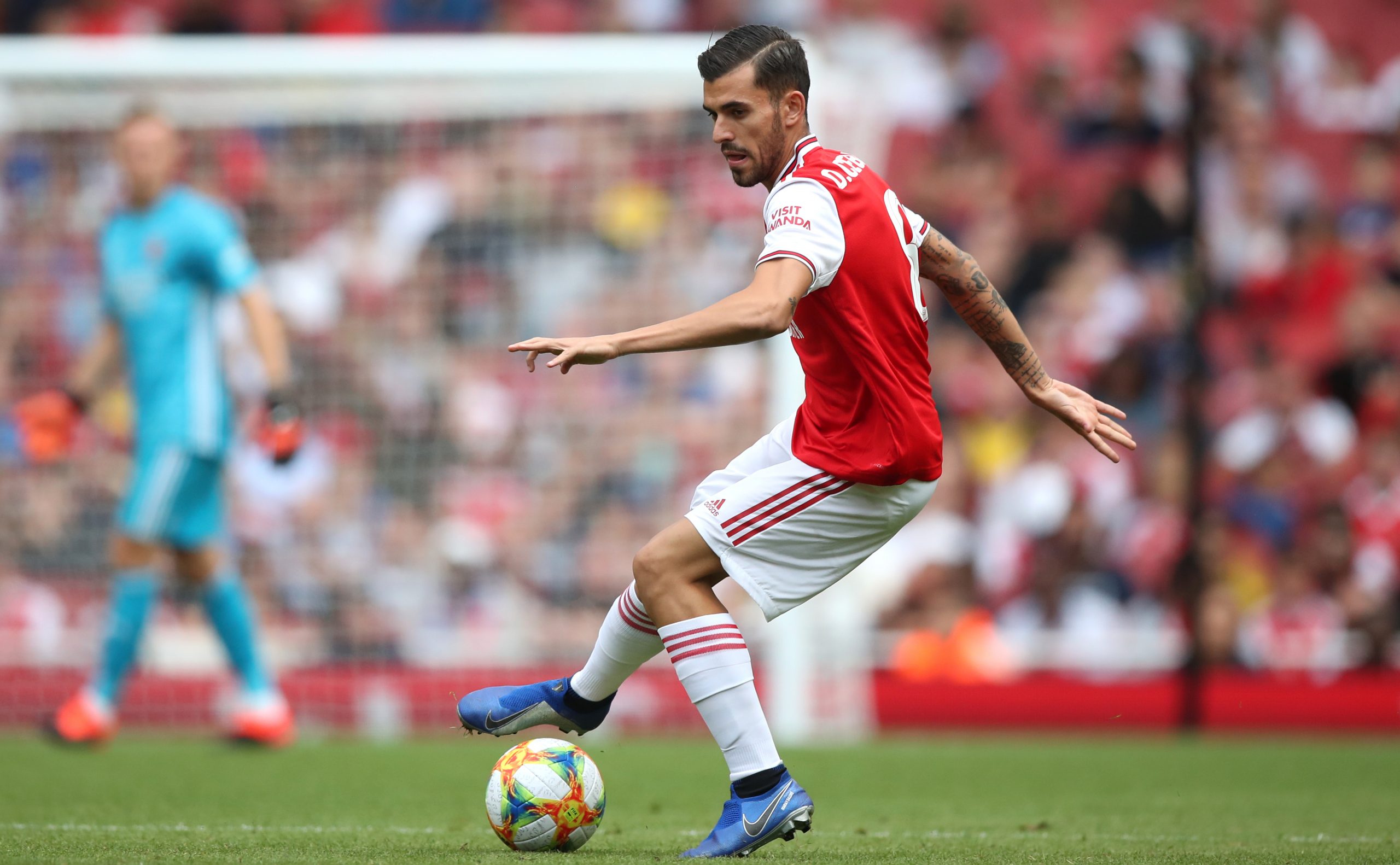New season, new look midfields.
Liverpool didn’t sign anyone of huge importance. Chelsea couldn’t sign anyone who wasn’t already registered at the club. Man Utd made the confounding choice to simply pretend the middle of the park doesn’t exist. But for the other three sides in the so called top six, arguably the most important additions they made were in midfield. It’s early days here of course, with both a period of adaptation allowed and the simple issue of a small sample size hurting any real analysis, but nonetheless there are initial signs that Rodri, Tanguy Ndombele and Dani Ceballos are changing how Manchester City, Tottenham and Arsenal play football. Let’s take a closer look at what each of the three are doing.
Rodri
A defensive midfielder has been Man City’s biggest and most obvious position of need for some time now. It’s not one that has gone unnoticed within the club, as City tried and failed to get Pep Guardiola’s biggest target in the role, Jorginho, last summer. What it meant was that City became ever so reliant on now 34 year old Fernandinho’s fitness to maintain the midfield control the system needed to function at its best. Still, City decided against signing a less ideal player last summer after Jorginho chose Chelsea, and their patience has paid off, with Guardiola now having someone with the ideal skillset for what he wants to do at the base of midfield.
What he wants to do might be slightly different from what we have seen previously. In City’s two title winning seasons under Guardiola, Fernandinho has been a permanent fixture in defensive midfield, an invaluable pillar upon which the side is built. What the Brazilian does is quite interesting. In terms of the defensive numbers he puts up, Fernandinho barely pressures the ball. He’s not traditionally involved in City’s high pressing game at all, as that work has already been done by those higher up the pitch, though his efforts have creeped up slightly in recent times. Take a look at his pressures per 90 when broken down into half seasons:
2017/18 (first half): 12.00
2017/18 (second half): 8.24
2018/19 (first half): 9.37
2018/19 (second half): 16.36
In the final stretches of last season, Fernandinho was pressuring opponents twice as frequently as twelve months ago. Obviously it wasn’t because a team that won 17 out of their last 18 games were suddenly rubbish at pressing from the front. But what it represented was a return to more midfield-focused play that defined an earlier part of Guardiola’s career. His Barcelona sides at times felt like exercises in fitting as many ball playing midfielders in a single team, with Sergio Busquets, Xavi, Andrés Iniesta, Thiago Alcântara and Cesc Fàbregas occasionally all getting into the same lineup in a system where the so called striker was Lionel Messi. This began to shift at Bayern Munich and really came to completion at City. In the Catalan’s second season, the preferred system would see Leroy Sané and Raheem Sterling stretched as wide as possible on their natural sides, while “free eights” Kevin De Bruyne and David Silva would frequently push high into the final third. Left back Fabian Delph would move into midfield to support Fernandinho, but the system still frequently felt like five defenders and five attackers.
This now seems to be changing. Last season saw Pep often move to playing inverted wingers, with Sterling now positioned much more narrow on the left. Riyad Mahrez seemed obviously signed as part of this plan to offer left footedness from the right, but towards the end of the year it actually ended up being Bernardo Silva taking up that role. The Portugal international is naturally more of a midfielder than Mahrez, so this tweaks the balance even further. And thus what it meant was that Fernandinho’s role changed. Before, he was more than anything else a get out of jail free card. On the rare occasion that City allowed the opposition to form any kind of real attack, Fernandinho could spring into life and fix it. But increasingly, City do have a “real” midfield, being asked to contribute consistently to both sides of the game. And that’s why Rodri has arrived.
In City’s first league game against West Ham, Rodri put up 28 pressure events, the most of any player for the away side. The following game against Spurs saw him manage 15, an obvious drop off but still quite a number considering Tottenham were barely able to get the ball out of their own half. Rodri felt like a slightly strange replacement for Fernandinho because he’s not really that similar a player, nor is Jorginho from the previous links. He probably doesn’t have the mobility to be the instant “fix” if the press goes wrong, and in possession he’s less forthright. Look at the passing sonars by comparison. On the left is Fernandinho last year, while on the right is Rodri for Villarreal in 2017/18 (chosen rather than Atlético Madrid last season because Simeone’s system is so different to Guardiola’s). Rodri’s passing is much tidier and calmer than what Fernandinho offered.
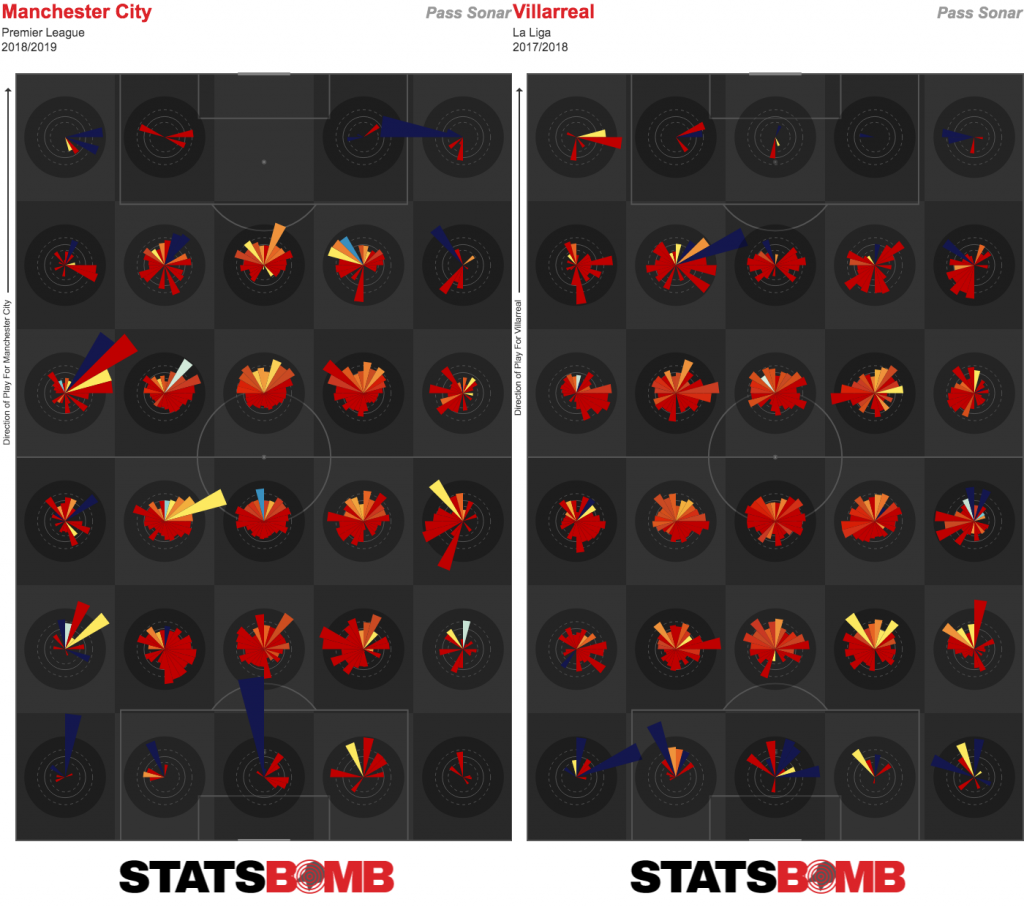
So Guardiola has someone who likely isn’t as mobile as Fernandinho, but is generally a more involved player without the ball and offers a shorter passing game. Are there any comparisons to work with here?
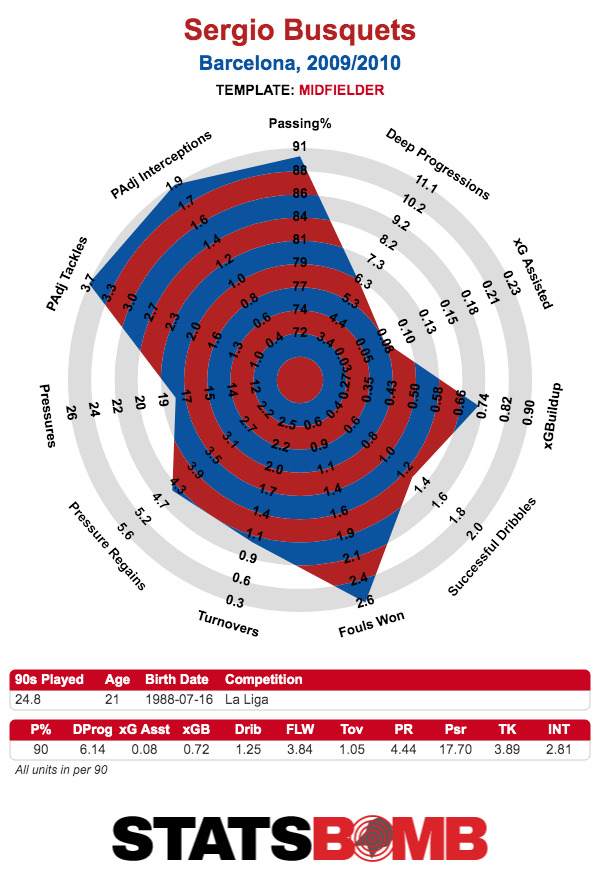
Ah. Looks like a move to more Barcelona-esque football is on and he’s found his new pivote.
Tanguy Ndombele
The thing about Tottenham’s midfield last season is that there wasn’t much of one. Mousa Dembélé was previously the engine that drove Spurs’ midfield with his one-of-a-kind ability to evade pressure to dribble and progress the ball through congested areas. With his physical decline came poorer performances and eventually a sale last January. That plus Eric Dier’s poor form and Victor Wanyama’s injuries meant that Spurs were awfully light in such a key area, so much so that Pochettino adapted to a style of football that attempted to make the midfield largely irrelevant. But that always felt like more of a quick fix than something the manager really believed in for the long term, so Spurs decided to spend a big chunk of money on a ready-made solution.
In Tottenham’s StatsBomb season preview, Joel Wertheimer gave us a flavour of what the Frenchman is intended to provide in North London:
“Ndombele solves almost all of the problems Tottenham had last season. His ball winning is excellent, and while not quite Mousa Dembélé level, he offers much more range than Tottenham had in midfield last season. He also adds the ball progression that the team sorely lacked from midfield last season, and is perhaps the best deep midfield passer Spurs have had under Mauricio Pochettino. Mousa Dembélé, who had an elite pass completion percentage rarely pinged balls across the park like Ndombele can, instead beating a man and finding a good, simple pass that way. Ndombele’s 0.13 open play expected assists per 90 minutes represents attacking incisiveness in midfield Spurs desperately needed. In Spurs’ first preseason match against Juventus, Ndombele showed Spurs fans what they have been missing, picking off a crossfield pass at the edge of the final third, taking two touches, and threading a gorgeous through ball to Lucas Moura for a goal.
Rather than being overstretched as the key player in midfield, the somewhat juvenated Moussa Sissoko will be able to play a more limited role. Harry Winks and Eric Dier will now be able to play at the base of midfield for Tottenham, and perhaps Dier can return to his old self after a season of never-ending maladies”.
And what have we seen so far? Signs are positive without being sensational. The game against Man City was one in which Spurs were penned deep into their own half, with Guardiola’s structured press being specifically aimed at stopping them from getting out. This was exactly the kind of situation where Dembélé would have been so useful in previous seasons, and one could easily imagine him playing through City’s press to get Spurs up the pitch. Ndombele is better than Dembélé at a number of things, but as seen from his dribbles and carries in this game, there weren’t too many occasions were he was able to really progress the ball that far forward.
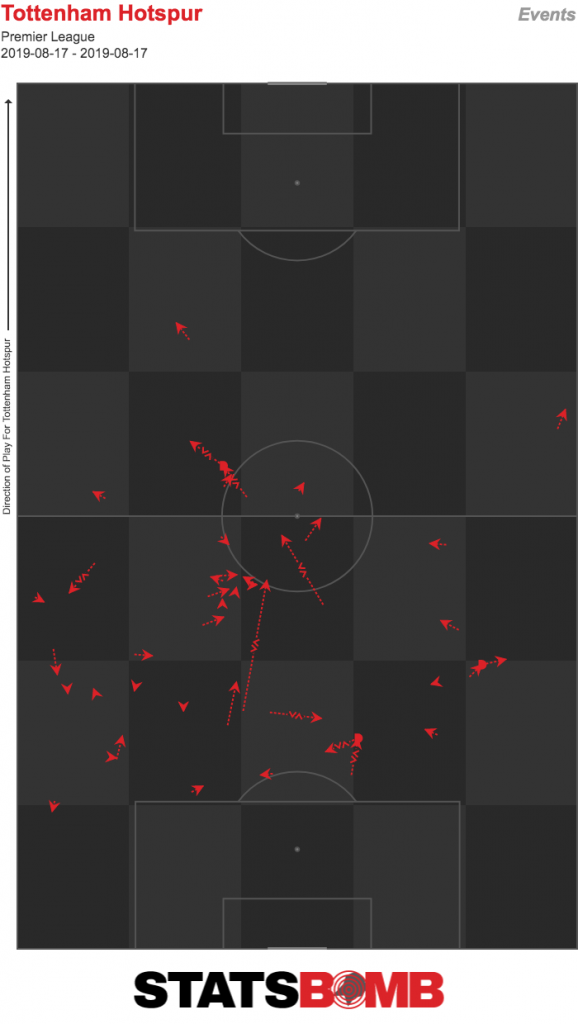
What he does have, as Wertheimer mentioned, is a better passing range. Ndombele managed three final third entries against City, and all three were passes. The former Lyon man is undoubtedly a hugely gifted midfielder, and almost certain to be an excellent signing for Spurs, but he is not an identikit replacement for his near namesake. Ndombele is at Tottenham to star in an all new midfield, not merely replicate what came before.
Dani Ceballos
While Ndombele and Rodri are filling clearly defined roles for managers with very distinct systems, Ceballos is arriving to something much more flexible. The most obvious person he’s replacing in the squad is Aaron Ramsey, who certainly had his qualities but in different ways to Ceballos. Ramsey offered a somewhat interesting package of being a decently involved midfielder in possession while still getting forward to add goals and assists and also putting up solid defensive work. He wasn’t always fit, but he offered a good mix of talents. One thing he did not do so well is dribble, and that’s where things change now. If you know Ceballos for anything, it’s probably those compilation videos of his fairly ridiculous dribbling skills through tight spaces and congested midfields. When looking at Arsenal’s other midfield options, you have good passers in Granit Xhaka and Mattéo Guendouzi, a strong ball winner in Lucas Torreira, creators who generally like to play higher up in Mesut Özil and Henrikh Mkhitaryan, but no hugely gifted dribbler until now.
Ceballos played in a slightly more advanced role than he traditionally has against Burnley, as a number ten behind Guendouzi and Joe Willock. Nonetheless, he still ended up picking the ball in plenty of different areas, and his dribbles and carries show a player quite adept at driving the ball forward.
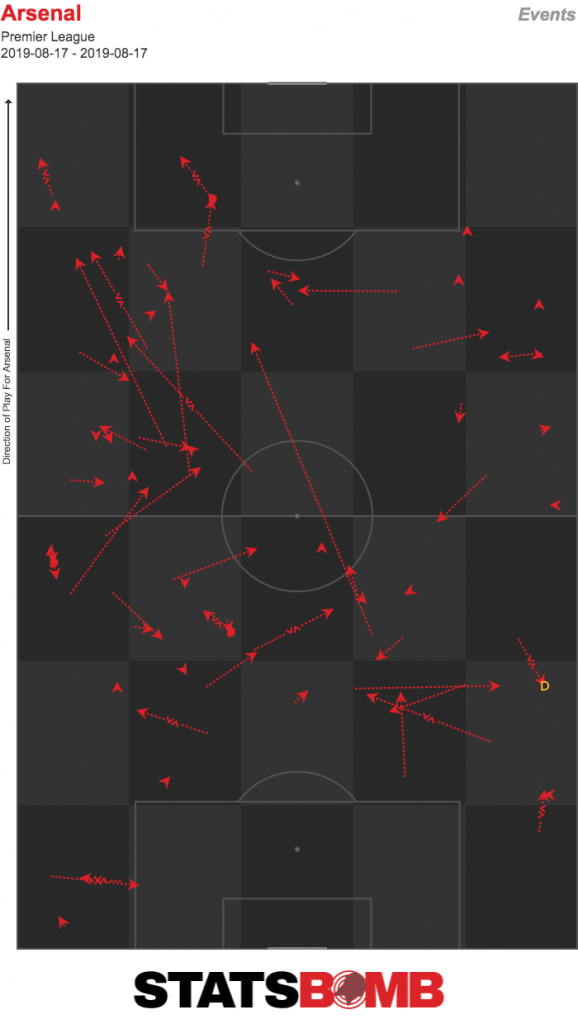
The question will be whether Ceballos is continually able to do this, or whether the more advanced role restricts him to being a pure number ten. That might be suboptimal, as it still feels like he produces his best work with more of the game in front of him. With Emery’s frequent tinkering he could easily tweak things if they’re not going so well. But regardless of position, Arsenal have themselves an excellent player who offers things no one else in their squad does.
